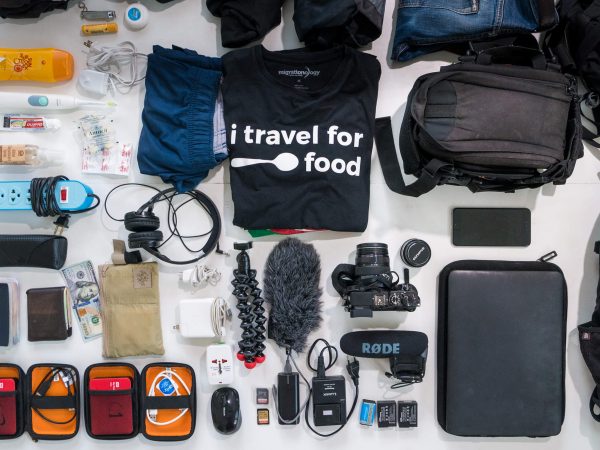

Guest Post: Today’s guest post is by Mei, a good blogging friend of mine who is a pharmacist from Malaysia, a serious foodie, and an expert on health and fitness. She runs CCFoodTravel.com and Cikipedia.
Mark’s Note: This article is not meant to scare anyone, but just to make everyone aware of potential diseases from certain symptoms. Diseases and infections are possible anywhere in this world, wherever you go, even at home – so there’s no reason to worry, but to just be aware. Southeast Asia by the way, has some of the most high-tech modern hospital facilities in the world.
Over to Mei…
Southeast Asia is one of the more popular travel destinations for people especially those living in the West.
The exotic lure of the heat and the beautiful beaches and dive spots of the tropics is really what puts South East Asia on the map for “must travel to” places.
However while traveling in Southeast Asia, unknown to many, is also a hotspot for emerging infectious diseases, including those with pandemic potential.
Southeast Asia is defined as the ten member countries of the Association of Southeast Asian Nations (ASEAN), a region with growing geopolitical influence in view of Asia’s global economic ascendancy. The ASEAN countries are Brunei, Cambodia, Indonesia, Laos, Malaysia, Myanmar, the Philippines, Singapore, Thailand, and Vietnam.
The recent emergence of a new strain (H5N1) of influenza A virus, the avian or bird flu, and the earlier outbreak of SARS, is proof of the fact that Asia might be the epicenter not only for influenza A viruses, but also for other contagious diseases.
In late 1992, Vibrio cholerae 0139 appeared on the Indian subcontinent and in a short span of time, it had spread to neighbouring countries. If you’re travelling to Southeast Asia, and planning to stay there long term, it’s good to know a little about the history of infectious diseases that have plagued this area of the world, just so you can take precautionary measures with your own health.
Get exclusive updates
Enter your email and I’ll send you the best travel food content.

Some of the major emerging infections are as follows:-
Enteroviruses
These viruses are generally mild and you might not even know that you’re infected. More severe forms of it cause infection of the central nervous system, resulting in aseptic meningitis and (rarely) paralysis; polioviruses.
Hand, foot, and mouth diseases, caused by enteroviruses, such as coxsackie A16 and entrovirus 71, is common in many countries in the region. Enteroviruses are normally associated with the hot and humid climate of tropical countries and is common even in my country Malaysia. There are many great night markets and places to visit for food but sometimes it’s best to err on the side of caution, especially if you don’t have the immunity or antibodies that the locals have.
Enteroviruses affect millions of people worldwide each year, and are often found in the respiratory secretions (e.g., saliva, sputum, or nasal mucus) and stool of an infected person.
Dengue
Dengue is very common in the tropics, even in my country Malaysia.
It manifests as high fever and a rash that breaks out all over the body. Dengue fever is a disease caused by a family of viruses that are transmitted by mosquitoes. Other symptoms include headache, fever, exhaustion, severe joint and muscle pain and swollen glands (lymphadenopathy). The presence (the “dengue triad”) of fever, rash, and headache (and other pains) is particularly characteristic of dengue fever.
If you have this – best to check into the nearest hospital immediately to do a white blood count (characteristically low platelet and white blood cell count in dengue). The haemorrhagic form of dengue fever, the dengue haemorrhagic fever (DHF), was recognized as a new disease in the Philippines in 1953 and has been seen in India, Malaysia, Singapore, Indonesia, Vietnam, Cambodia, and Sri Lanka.
The rise of dengue in tropical parts of the world is due to rapid population growth, expanding urbanization, inadequate municipal water supplies, and difficulties in refuse disposal. These lead to an abundance of new breeding sites for the mosquito vectors, while human migration patterns disperse vectors and viruses into new areas.
Chikungunya Virus
Chikungunya is an insect-borne virus, of the genus Alphavirus, that is transmitted to humans by virus-carrying Aedes mosquitoes.
Chikungunya virus was relatively common in southern and south-eastern Asia in the 60’s. After causing outbreaks in India, Sri Lanka, Burma, and Thailand, it all but disappeared, and sporadic cases continued in Burma, Thailand even into the 80’s.
In addition, the virus spread into Indonesia for the first time from 1982 to 1985. Outbreaks occurred in Thailand in 1995 and Malaysia in 1998 to 1999.
Emerging Zoonotic Viruses
A zoonosis is any infectious disease that can be transmitted between species, i.e. from animals to humans or from humans to animals (the latter is sometimes called reverse zoonosis or anthroponosis).
A number of viruses have emerged from fruit bats (flying foxes), particularly members of the genus Pteropus, over the past 10 years. These include the Hendra and Nipah viruses.
Nipah Virus
This epidemic happened in my own backyard. A major outbreak of disease in pigs and humans from September 1998 to April 1999 resulted in 265 infected persons, 105 of whom died, and the eventual destruction of about 1.1 million pigs, in Malaysia.
The predominant clinical syndrome in humans was encephalitis which manifested symptoms such as fever, headache, drowsiness, and disorientation, and if you are unlucky, coma. Most infected persons had a history of direct contact with live pigs, and most were pig farmers. But still the virus managed to get out of hand when crossed over from farms, farmers to the average person on the street. In the end, millions of pigs had to be culled to stop the spread of the disease.
Conclusion – Precaution
In the course of long term travel to Southeast asia, it is inevitable that one might end up in an area with an outbreak, especially of one is planning to stay there long term.
However it’s good to know a little about the signs and symptoms of infectious diseases in your region, just so you can take precautionary measures with your own health.
If you have any suspicious symptoms such as fever, rash and headache, do not procrastinate – check yourself into the nearest hospital immediately. This could mean the difference between life and death.
About the Guest Writer:
 Cikipedia is about Ciki, a 30-something pharmacist, who looks like a 20-something (Don’t believe us? Ask her friends!) Though she studied conventional medicine, she has a keen interest in alternative forms of treatment and medication that she believes are essential to the well-being of the human body. We cannot reverse time, but we sure can slow down the aging process! Cikipedia is a health, fitness and travel blog. Follow this blog and learn Ciki’s personal routines on how she stays fit, energetic and young at heart. Follow her on Twitter too!
Cikipedia is about Ciki, a 30-something pharmacist, who looks like a 20-something (Don’t believe us? Ask her friends!) Though she studied conventional medicine, she has a keen interest in alternative forms of treatment and medication that she believes are essential to the well-being of the human body. We cannot reverse time, but we sure can slow down the aging process! Cikipedia is a health, fitness and travel blog. Follow this blog and learn Ciki’s personal routines on how she stays fit, energetic and young at heart. Follow her on Twitter too!
In her spare time, Ciki writes for her Food and Travel blog too, CCFoodTravel.
Get exclusive updates
Enter your email and I'll send you the best travel food content.



